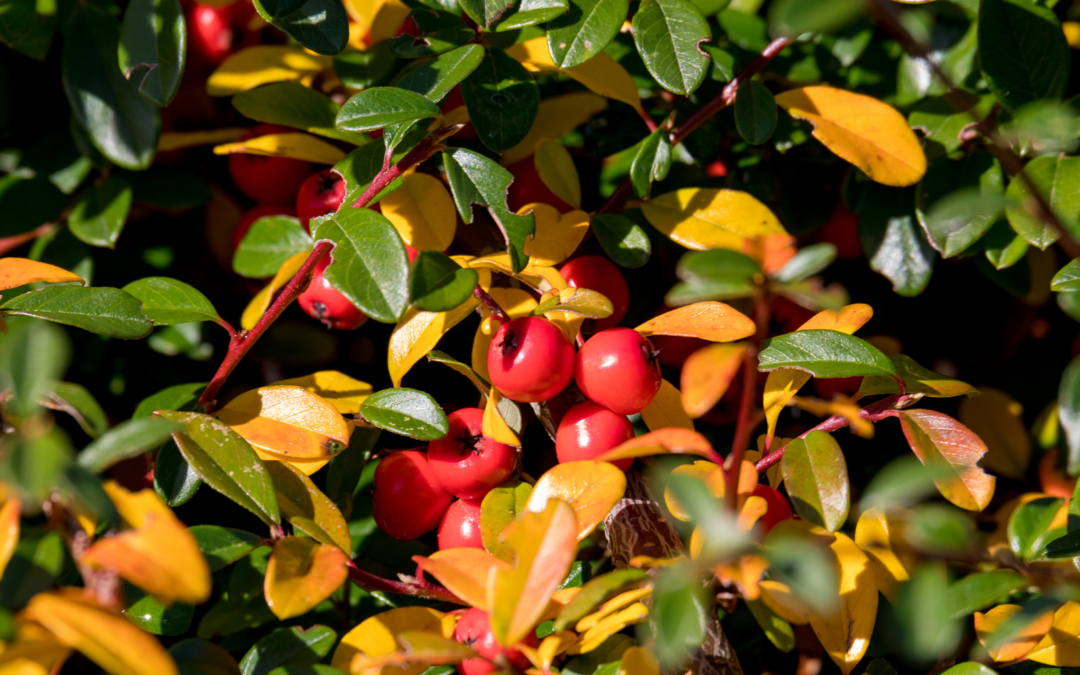What’s A Shrub?
Is it a tree? Is it a bush? No, it’s shrub! Shrubs are like the middle sibling to trees and bushes. Unlike trees, shrubs are much smaller. They grow a central base with many small and woody branches stemming from the bottom to the top. Yet, shrubs are still slightly bigger than a bush with much less branches and more shape. Shrubs come in many different colors, shapes and sizes. Some with berries, some with flowers and some with both. They build beautiful landscapes, create privacy and help us breathe. Shrubs also provide food for the bees, the birds and sometimes, even us humans.
Why Fall?
If you have tried planting a shrub in the summer you know that it takes up a lot of time and energy caring for them. Summertime plantings are very stressful on all plants as it’s too hot and too dry. If you’re not outside watering your shrub with gallons of water every day, it will start to struggle and this is when you’ll notice your shrub leaves starting to fall off or it might just become droopy and sad looking.
If you’re looking to plant shrubs, fall is the best time to do so. The warm soil and crisp cool air that fall brings, promotes root growth for plants. An established root system is what you’ll want to keep your shrubs in place, allowing them to grow healthy and strong before the ground freezes. Here are a few unique shrubs to inspire you while it’s still the perfect time to plant them.

Snowberry – Native to North America, this shrub belongs to the honeysuckle family and is often left alone by the browsing deer. The Snowberry is known for it’s gorgeous pink, white, purple or red berries. Growing 1-6 ft tall and wide. Snowberry prefer full sun to partial shade with a minimum of 4 hours of indirect sunlight. If you live in zones 3-7, with dry or poor soil, the Snowberry is a great option for you as they can tolerate poor soil conditions.

Pussy Willow (Salix caprea) – Native to North America, the pussy willow is also know as goat willow. Historically used for its anti-inflammatory properties- it has been used by herbalists to treat joint and muscle pain, fever, headache and more! Pussy willows grow in zones 4-8, in full to partial shade with a minimum of 4 hours of direct sunlight each day. You can expect this large shrub to grow 15-25′ tall and 12-25′ wide. Making this a great shrub choice for anyone looking to build privacy.

Hydrangea – With over 75 different species the Hydrangea is native to both Asian and America. Depending on the variety you choose, Hydrangeas can blossom in the spring, summer or fall with large scented or unscented flowers. In zones 3-7, this shrub loves morning sun but not afternoon sun. Plant your Hydrangea in well drained soil, facing north or south. Hydrangeas are famous for their beautiful color variations, making them a popular shrub choice for those looking to add some some color to their landscape.

Viburnum – Belonging to the Adoxaceae family. Viburnums can grow anywhere between 2-30ft are there are both evergreen and deciduous varieties. They have clusters of blooms at the end of each branch, ranging from sweet to unpleasantly scented depending on the type. Grown in zones 2-9, Viburnums prefer moist and well-drained soil with plenty of sunlight. These shrubs provide both berries and flowers which are great for attracting the birds and bees! If you are looking to attract more wildlife to your garden- a viburnum will do the trick.

Pyracantha – A very thorny evergreen shrub that is native to Europe and Asian is not on the deer menu. This perennial shrub can grow up to 12 ft tall and wide which makes a great privacy screen. Pyracantha have fragrant white blossoms in late spring with long lasting orange, red or yellow berries thereafter depending on the type you choose. A tasty treat for the birds, the bees and the butterflies. The berries on Pyracantha can last through winter giving you a much needed burst of colour. This shrub is a fan favorite for gardeners looking to get a fresh summer feel all year round.

American Elderberry – Native to Europe and America, the Elderberry is one of the easiest shrubs to grow. With many variations, you can grow this shrub in wide variety of growing conditions and zones. The American Elderberry can grow up to 12 ft tall and 6 feet wide. In zones 3-9, this shrub prefers full sun to partial shade and almost any type of soil that is well draining. Once fully ripened in August or September, the Elderberry can be harvested for cooking or eating raw. The perfect shrub for snacking!
Don’t Forget
If you’re ready to take the next step by introducing a shrub to your yard, just be sure to read the care instructions. Each shrub comes in many different varieties, and you want to make sure the shrub you choose is the going to thrive in your growing conditions. For more shrub inspiration, check out this episode of Get Up and Grow: Shrubs and Tree’s That Add Brilliant Fall Color to Your Garden, with President of Wildwood Outdoorliving, Gord and Chek News Journalist Jasmine Bala, below. Happy Gardening!
Have a question? Let us know at info@wildwoodoutdoorliving.com.
Sign up here for more blogs dedicated to better gardening


